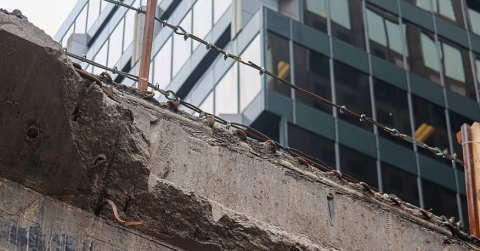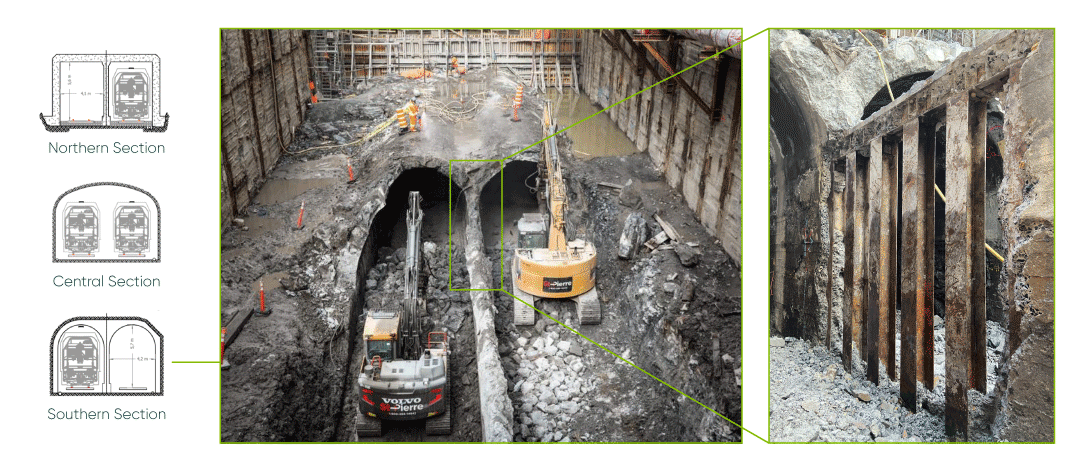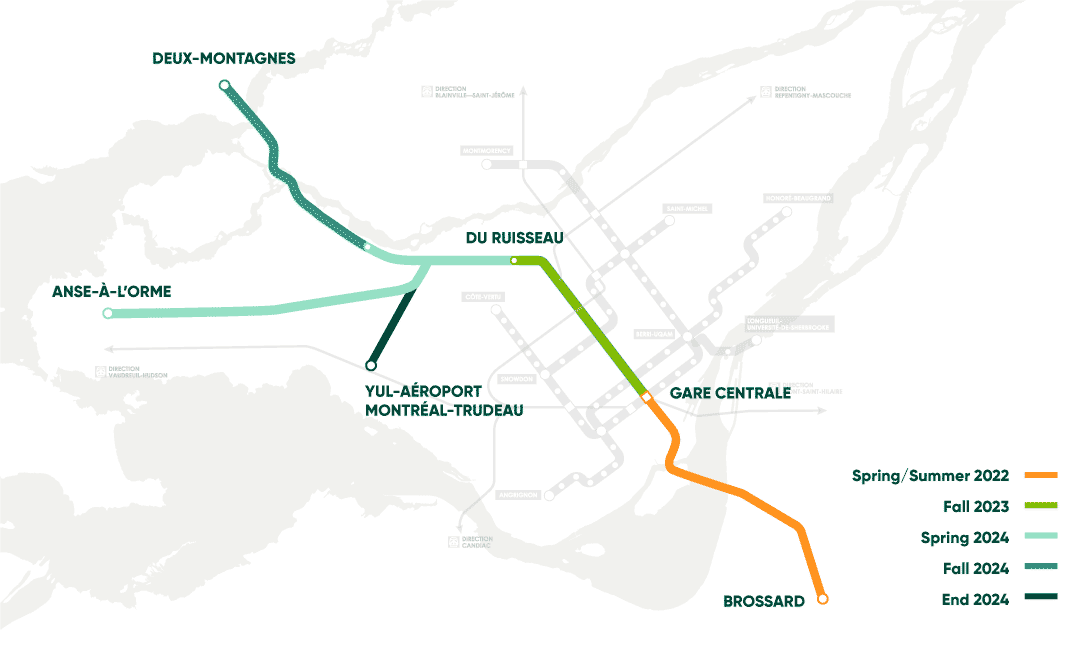
COVID-19 and the safety of the Mount Royal Tunnel: what to know about the updated REM schedule in relation to the exceptional events of 2020
Update
The REM commissioning schedule has been updated. To view the latest version, visit our Work Schedule page.
2020 has been a year without precedent for everyone. In addition to grappling with COVID-19 and a shutdown period last spring, the crews identified two major safety issues related to the Mount Royal Tunnel while its modernization was getting under way.
These two issues, together with the changes made necessary by COVID-19, have led us to revise the planned schedule for commissioning the different branches of the REM.
Here is an overview of what you need to know so as to fully understand the updated schedule.
COVID-19: a shutdown period, but also new measures to be observed
Last March, in accordance with the government’s directive, all Quebec construction sites were put on hold.
Work was resumed on May 11, 2020, but the return to the work sites was gradual since it involved mobilizing teams who had been out of action for several weeks. This gradual restart, along with supplying the material required for a safe resumption of work, took several weeks.
Next, in order to enable the restart of work activities, it was essential that we first ensure the health and safety of the workers. Thus, many measures have been added in order to guard against the spread of COVID-19. For more information on these measures, consult the article here. Finally, COVID has also affected the mobility of skilled labour and impacted the supply chain.
Based on analysis of the situation in recent months, all REM yards have been affected by a slowdown of about 6 months. We continue to monitor the situation, as the COVID-19 pandemic is still present.
The Mount Royal Tunnel: two major safety challenges
The complete closure of the Mount Royal Tunnel on last May 11 marked the start of work to modernize this century-old tunnel, which was inaugurated in 1918, in the midst of the Spanish flu pandemic.
This unhindered access to the tunnel, however, led construction crews to identify two major and unpredictable safety issues within this tunnel, which had been in operation for over 100 years.
1. Unexpected detonation of a century-old explosive:
This summer, as excavation began inside the Mount Royal Tunnel, a detonation occurred in the tunnel. The work was immediately suspended and no workers were injured. After analysis and investigation, it was determined that the most likely cause was the interception by a drill of an old borehole containing an explosive charge dating from the tunnel construction period in 1912. The thermal heat from the drill tip would have led to the detonation of this forgotten explosive, which was more than 100 years old.

In conjunction with experts and research chairs, strict measures approved by the Commission des normes, de l’équité, de la santé et de la sécurité du travail (CNESST) have been established to continue the tunnel modernization work starting in early November.
These measures include the respect of exclusion zones for workers during drilling activities and the use of remotely controlled equipment to ensure the safety of site personnel.

2. Significant structural degradation of the southern section of the tunnel:
While conducting intrusive inspections in the tunnel in downtown Montreal, the teams noted a very advanced state of structural degradation of the walls.
This is explained by the use of de-icing salt on McGill College Avenue for many years, combined with the lack of waterproofing membranes on the tunnel, which caused infiltration in the concrete and corroded the steel columns and beams of the vault. The state of degradation of this section of the tunnel was thus much more advanced than anticipated. This degradation poses a potential risk to the structural integrity of McGill College Avenue.
Thus, rehabilitation and reconstruction work is required to ensure the safety and sustainability of this infrastructure. Among the four options evaluated for the reinforcements, the option that minimizes the impacts for the City of Montréal and surface users was chosen. This reinforcement work will therefore be undertaken from inside the tunnel and not from the surface, which would have had major impacts on traffic.

These two events will require an additional period of time to complete the required safety work, which will delay the opening of the segment between Central Station and Du Ruisseau Station to the fall of 2023, representing 18 months of work.
The commissioning of the Mount Royal Tunnel also influences the opening of the Anse-à-l’Orme, Deux-Montagnes and Airport branches, since this is the central segment. Thus, a period of dynamic tests and trials on the other branches can only start once the tunnel is commissioned, and this period will take about 6 months.
With respect to the Airport branch, the impacts related to COVID-19 and to this required testing period are also combining with delays in getting the tunnel boring machine operational.
Updated project schedule
COVID-19, as well as the two unforeseen issues in the safety of the Mount Royal Tunnel, are delaying the commissioning of the various REM branches.

Commissioning of the South Shore to Central Station segment is postponed to Spring/Summer 2022. On the Deux-Montagnes line, the commissioning will still be done by segment (fall 2023 for the Central Station to Du Ruisseau segment, spring 2024 for Du Ruisseau to Sunnybrooke and fall 2024 for Sunnybrooke to Deux-Montagnes). Commissioning of the West Island segment is scheduled for spring 2024 and that of the airport antenna is scheduled for the end of 2024.
Thanks to the workers
Building the REM represents more than twenty construction sites throughout the Greater Montreal area and more than 2,000 workers and professionals are on the job.
In this exceptional situation, where Quebec is part of an unprecedented global health crisis and unforeseen issues can arise, it is essential that we highlight the immense contribution of the workers who are moving this project forward by leaps and bounds. We must also salute the work of the health and safety managers who enabled us to ensure the continuity of operations, construction and other activities on all REM building sites.
“This is an important year from every point of view. I am proud of the work accomplished by our teams, who are working tirelessly to deliver a world-class public transit project to the people of Greater Montreal, despite a year marked by exceptional events,” said Macky Tall, President and CEO of CDPQ Infra.
![]()
Achievements of 2020 in a few figures:
- Kilometres of track installed: 9
- Stations under construction: 17
- Kilometres of aerial structures installed: 10
- Number of segments installed: 2162
- Number of spans installed: 78
- Number of pillars installed: 455
- Excavated rock in cubic metres: 22,791
Consult the complete technical presentation: